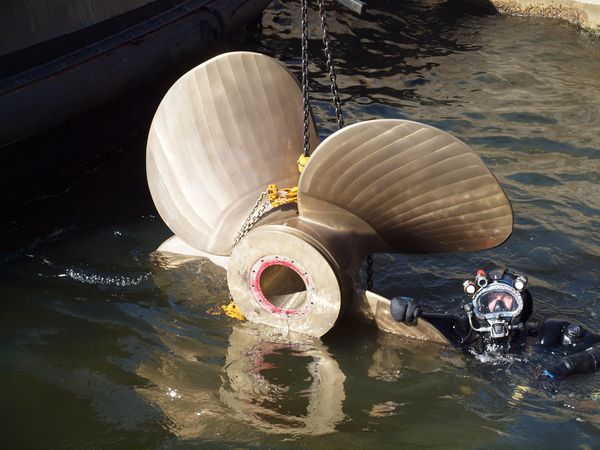While negotiations about a propulsion retrofit for an ASD tugboat are underway, a fit-for-purpose idea comes to light: what if the propulsion solution could accommodate seasonal change – namely, eliminating the ever-present hassle provided by ice during winter operations?
Artemis, one of the longest serving Azimuth Stern Drive (ASD) tugboats in the Alfons Håkans fleet, needed a propulsion boost. Tuomas Raumanen, Technical Manager for Turku-based Alfons Håkans, recalls that the company was thinking about various alternatives in the autumn of 2021. The propulsion unit was 40 years old and nearing the end of its life cycle.
“We knew that a major overhaul would be costly and take a long time to perform. The alternative was getting a new propulsion unit as a retrofit,” Raumanen explains.
“We were also interested to upgrade thrusters to new model with a slipping clutch. Original propulsion units did not have a slipping clutch function and manoeuvring of the tug was sometimes demanding, especially in small harbor basins,” he adds.
Alfons Håkans, one of the leading towage and salvage companies in the Baltic Sea, asked around for offers. The company soon got into talks with Steerprop, a leading designer and manufacturer of propulsion systems for the most demanding applications and toughest conditions, who had just collaborated with the company regarding the very same ship.
“Steerprop had just modernized and upgraded the control system on Artemis and we had good relationship,” explains Raumanen.
“As a consequence, we decided to make a deal for the new propulsion unit retrofit with them.”
Dealing with ice
So far, everything was proceeding as it regularly would. At this time, however, Raumanen started thinking: could the Steerprop delivery scope be modified somehow to take care of a persistent problem that tugboats keep facing in the winter?
“The propulsion units feature nozzles that get jammed up with crushed ice during winter,” Raumanen explains, adding that, for example, most port areas are plagued with just such ice.
The ice will get stuck in the nozzles and propulsion performance will drop dramatically. Furthermore, emptying the ice from the nozzles is a time-consuming job that is not exactly easy to pull off.
Raumanen challenged the Steerprop design team to come up with a solution: instead of welded-in nozzles, would a more “mobile” system work? That way you could take away the nozzles in the wintertime when ice becomes an issue – and simply put them on again after winter.
Rising to the challenge
Juho Rekola, Director, Sales and Project Management, from Steerprop says that the design team immediately saw the value in the idea. “Nozzles filling with crushed ice is a potentially a very serious safety issue, not to mention the drop in performance level. We were eager to tackle this challenge,” Rekola says.
A fit-for-purpose concept begun to take shape soon. Instead of welding the nozzles in place, one could bolt them in – and remove them at your leisure. The trick, however, was that you would have to do it under water.
“I contacted local DG Diving Group who have lots of experience from demanding projects – and they were confident that they could get it done,” says Tuomas Raumanen.
Next up, the Steerprop professionals came in to install the propulsion unit, but the question remained: will the underwater operation bring the desired end result? The moment of truth finally arrived at the end of February, 2024, as it was time to remove the nozzles – as well as replace the “summertime propeller” with a “winter propeller” – in the freezing-cold water. Steerprop’s most experienced technician stood by on the pier, ready to offer assistance.

The switch would take time even under best of circumstances. “If you do this same procedure on dry dock, it’ll take 4-5 days to perform. We couldn’t know in advance, how fast things would happen under water,” Raumanen says. However, with a dry dock certain extra expenses are known: for example, reserving and getting the vessel to available drydock takes time and runs up the cost.
Beneath the surface
Everybody was most pleasantly surprised when the diving team pulled off the job in four days. “The Steerprop technician remarked that most dry docks couldn’t move that fast,” grins Raumanen.
“And think of the conditions: for example, managing 10 mm nuts with your bare hands in Baltic Sea in February is not for everybody,” Raumanen gives credit to the diving team which numbered 2-3 divers, depending on the work phase.
Juho Rekola agrees: the divers really did the “heavy lifting” here, making it possible to pursue a wild idea to its fruition. “The collaboration in this project was outstanding throughout,” he adds.
All that hard work paid off. Raumanen reports that the feedback from Artemis, back upon the waves in March, has been only positive.
It was great to see how well everything has been working, and the operability of the propulsion unit remains solid. This concept with dismountable nozzles means that we can use Artemis also in the hardest ice conditions during wintertime which was not possible with original thruster units.
The tugboat will return to ‘summer mode’ in April, as the nozzles are installed back in by divers.
Solve any problem
Looking back at the entire project, Raumanen says that Steerprop – once again – gave an impressive showing with its flexibility and ability to think outside the box.
Furthermore, when we ask, can this be done, the answer is never ‘no’. Instead, they say ‘let us get back to you’ and figure out the best way forward, says Raumanen.
The ‘nozzle on, nozzle off’ concept is now included in the retrofit scope of another Alfons Håkans vessel: tugboat Apollon will be fitted the same way, reveals Raumanen.
“We’re happy to expand on a winning concept,” he adds.
